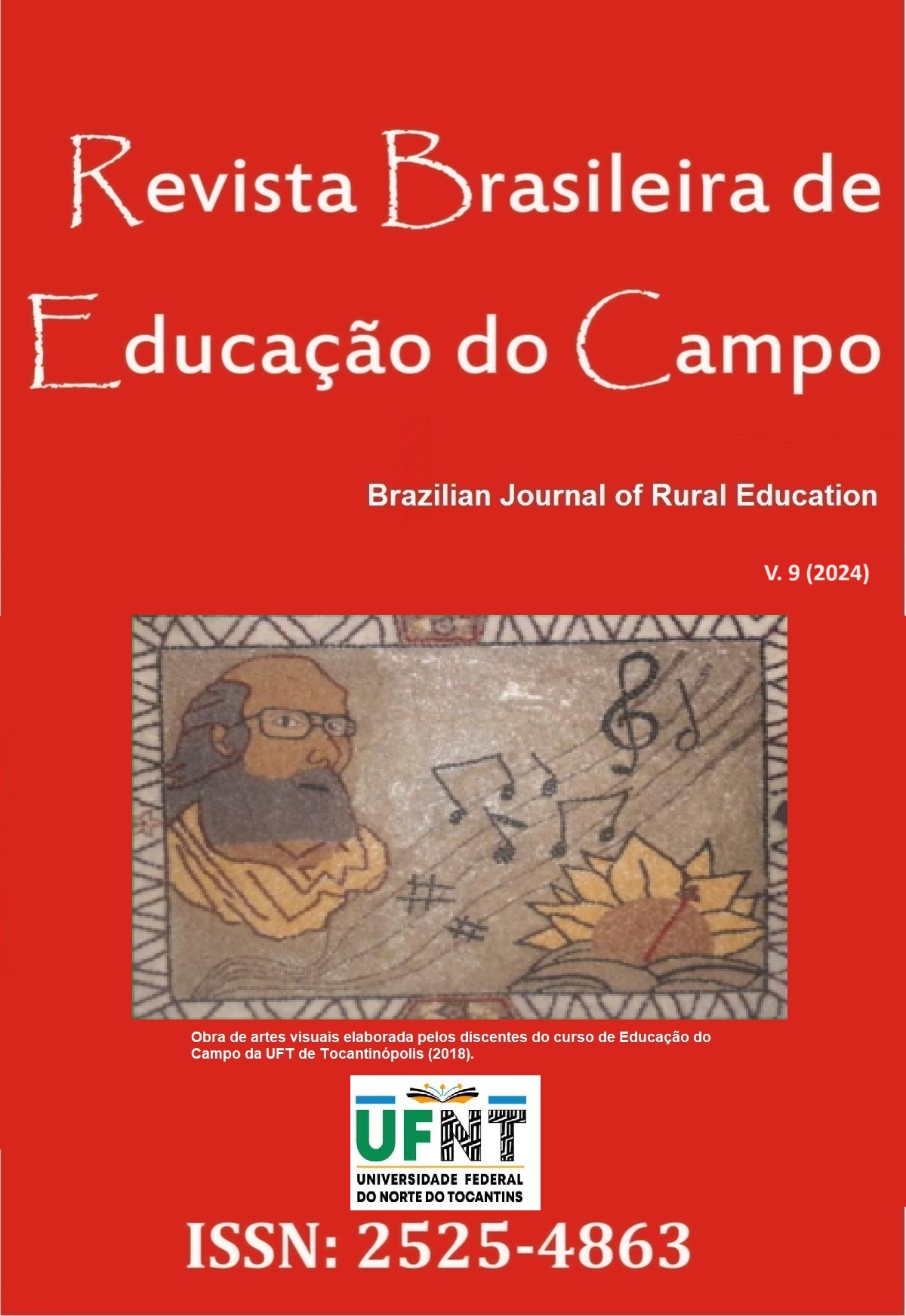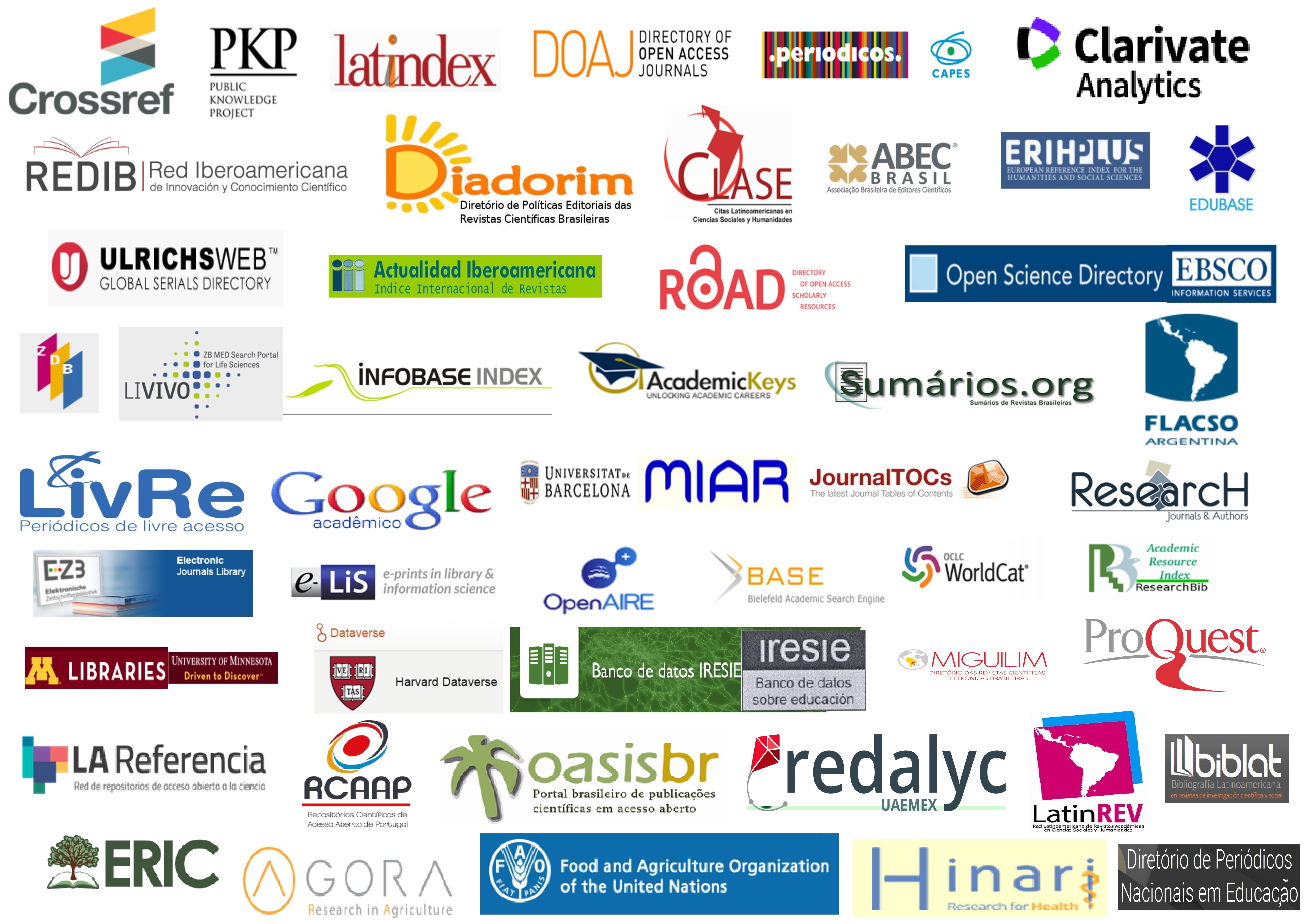Fenómeno de abandono escolar en áreas de alta vulnerabilidad: resultados de un metaanálisis
DOI:
https://doi.org/10.70860/ufnt.rbec.e19190Resumo
Fenómeno de abandono escolar em zonas de grande vulnerabilidade: resultados de uma meta-análise
O artigo apresenta os resultados de uma meta-análise realizada para compreender se e em que medida existem provas que demonstrem se os acontecimentos catastróficos têm influência nas taxas de abandono escolar ou nas abandono dos alunos. A investigação salienta que acontecimentos destrutivos como terramotos, furacões, inundações, etc., podem levar a perturbações no ambiente de aprendizagem, aumentando os níveis de stress e o risco de abandono escolar entre os alunos que residem em áreas afectadas e com baixos rendimentos. Foi demonstrado que o encerramento de escolas devido a catástrofes tem um efeito prejudicial no desempenho académico e no abandono escolar, tanto nas populações previamente em risco como nas populações já vulneráveis antes da catástrofe, o que levaria os alunos a terem maior probabilidade de abandonar a escola. No entanto, diferentes tipos de catástrofes, como os fenómenos geológicos e climáticos, podem ter impactos diferentes no abandono escolar, sendo que as catástrofes climáticas, como a seca, prejudicam, nalguns casos, significativamente a obtenção da educação em mais de 40% e aumentam o abandono escolar precoce, especialmente entre as mulheres jovens e os alunos mais fracos ou em risco. Estas conclusões sublinham a necessidade de intervenções adaptadas e de sistemas de apoio para atenuar os efeitos negativos das catástrofes naturais na educação dos estudantes.
Palavras-chave: abandono escolar, catástrofe natural, acontecimento catastrófico, zonas de grande vulnerabilidade, factores de risco.
Fenómeno de abandono escolar en áreas de alta vulnerabilidad: resultados de un metaanálisis
RESUMEN. El artículo presenta los resultados de un metaanálisis realizado para comprender si existe evidencia y en qué medida que muestra si los eventos catastróficos influyen en las tasas de deserción escolar o sobre el abandono escolar. Las investigaciones destacan que los eventos destructivos como terremotos, huracanes, inundaciones, etc., pueden provocar interrupciones en el entorno de aprendizaje, aumentar los niveles de estrés y el riesgo de abandono escolar entre los estudiantes que residen en áreas afectadas y de bajos ingresos. Se ha demostrado que el cierre de escuelas debido a desastres tiene un efecto perjudicial en el rendimiento académico y la deserción escolar, tanto en las personas que antes estaban en riesgo como en las poblaciones que ya eran vulnerables antes de un desastre, lo que haría que los estudiantes tuvieran más probabilidades de abandonar la escuela. Sin embargo, los diferentes tipos de desastres, como los fenómenos geológicos y climáticos, pueden tener diferentes repercusiones en la deserción escolar, ya que los desastres climáticos, como la sequía, obstaculizan, en algunos casos, significativamente el logro de la educación en más de un 40% y aumentan el abandono escolar prematuro. Especialmente entre las mujeres jóvenes y los estudiantes que están más débiles o en riesgo. Estos hallazgos subrayan la necesidad de intervenciones y sistemas de apoyo adaptados para mitigar los efectos negativos de los desastres naturales en la educación de los estudiantes.
Palabras clave: abandono escolar, distaster natural, evento catastrofático, áreas de alta vulnerabilidad, factores de riesgo.
Dropout phenomenon in areas of high vulnerability: results of a meta-analysis
ABSTRACT. The article presents the results of a meta-analysis conducted to understand if and to what extent there is evidence that shows whether catastrophic events have an influence on school dropout rates or student dropout rates. Research highlights that destructive events such as earthquakes, hurricanes, floods, etc., can lead to disruptions in the learning environment, increasing stress levels and the risk of dropping out among students residing in affected and low-income areas. School closures due to disasters have been shown to have a detrimental effect on academic performance and dropout, in those previously at risk and in those pre-disaster populations that are already vulnerable, which would cause students to be more likely to drop out of school. However, different types of disasters, such as geological and climatic events, can have different impacts on dropout, with climate disasters such as drought hindering, in some cases, significantly the attainment of education by more than 40% and increasing early school leaving, especially among young women and students who are weaker or at risk. These findings underscore the need for tailored interventions and support systems to mitigate the negative effects of natural disasters on students' education.
Keywords: scholastic dropout, natural distaster, cathastrophic event, areas of high vulnerability, risk factors.
Downloads
Referências
Abramson, D. M., Park, Y. S., Stehling-Ariza, T., & Redlener., I. (2010). Children as Bellwethers of Recovery: Dysfunctional Systems and the Effects of Parents, Households, and Neighborhoods on Serious Emotional Disturbance in Children After Hurricane Katrina. Disaster Medicine and Public Health Preparedness, 4(S1), S17-S27. https://doi.org/10.1001/dmp.2010.7 DOI: https://doi.org/10.1001/dmp.2010.7
Akram, O., Chakma, J., & Mahbub, A. (2012). Continuing education in disaster-affected schools in Bangladesh: an evaluatio of the Education in Emergencies Project. Children Youth and Environments, 22(2), 249-262. http://www.colorado.edu/journals/cye. DOI: https://doi.org/10.1353/cye.2012.0009
Alamir, A., & Heidelk, T. (2020). Natural Disasters and Education. Working Papers ECARES 2020-05, ULB - Universite Libre de Bruxelles.
Alisic, E., Bus, M., Dulack, W., & Splinte, J. (2012).Teachers' experiences supporting children after traumatic exposure. Journal of Traumatic Stress, 25(1), 98-101. https://doi.org/10.1002/jts.20709 DOI: https://doi.org/10.1002/jts.20709
Anderson, W. (2005). Bringing children into focus on the social science disaster research agenda. International Journal of Mass Emergencies and Disasters, 23(3), 159-175. https://doi.org/10.1177/028072700502300308 DOI: https://doi.org/10.1177/028072700502300308
Arredondo, J. (2016). Empowering the Poor Through Education in Bangladesh. The Borgen Project. Typology of school dropout: The dimensions and dynamics of dropout in Ghana ED Ananga. International Journal of Educational Development, 31(4), 374-381. DOI: https://doi.org/10.1016/j.ijedudev.2011.01.006
Arumugan, S., & Nagabalasubramanian, P. B. (2023). School Dropout an Evil, who is Socially Responsible? A Study. The Ciência & Engenharia - Science & Engineering Journal, 11(1), 185-196. https://doi.org/10.52783/cienceng.v11i1.111 DOI: https://doi.org/10.52783/cienceng.v11i1.111
Aubrecht, C., Steinnocher, K., Köstl, M., Züger, J., & Loibl, W. (2013). Long-term spatio-temporal social vulnerability variation considering health-related climate change parameters particularly affecting elderly. Natural Hazards, 68(3), 1371-1384. https://doi.org/10.1007/s11069-012-0324-0 DOI: https://doi.org/10.1007/s11069-012-0324-0
Azevedo, J. (2023). School participation in marginalization and students leaving school: The case of Portugal. Education Policy Analysis Archives, 31. https://doi.org/10.14507/epaa.31.7629 DOI: https://doi.org/10.14507/epaa.31.7629
Beaglehole, B., Bell, C., Frampton, C., & Moor, S. (2017). The impact of the Canterbury earthquakes on successful school leaving for adolescents. Australian and New Zealand Journal of Public Health, 41(1), 70-73. https://doi.org/10.1111/1753-6405.12625 DOI: https://doi.org/10.1111/1753-6405.12625
Bonanno, G., Brewin, C., Kaniasty, K., & La Greca, A. (2010). Weighing the Costs of Disaster: Consequences, Risks, and Resilience in Individuals, Families and Communities. Psychological Science in the Public Interest, 11(1), 1-49. https://doi.org/10.1177/1529100610387086 DOI: https://doi.org/10.1177/1529100610387086
Briggs, B., 2018, Education under attack and battered by natural disasters in 2018, viewed 15 February 2022, from www.theirworld.org
Brummet, Q. (2014). The effect of school closings on student achievement. Journal of Public Economics, 119(C), 108-124. https://doi.org/10.1016/j.jpubeco.2014.06.010 DOI: https://doi.org/10.1016/j.jpubeco.2014.06.010
Chávez-García, W., Moreira-Morales, D., Manzaba-Basurto, L., Álava-Castro, D., Avila-Rosales, F. (2023). School dropout in the face of the COVID-19 pandemic in upper basic students of the Bachillero educational unit. International journal of social sciences, 6(2), 77-82. https://doi.org/10.21744/ijss.v6n2.2121 DOI: https://doi.org/10.21744/ijss.v6n2.2121
Chen, R. (2012). Institutional characteristics and college student dropout risks: a multilevel event history analysis. Research in Higher Education, 53(5), 487-505. https://doi.org/10.1007/s11162-011-9241-4 DOI: https://doi.org/10.1007/s11162-011-9241-4
Chiusaroli, D. (2022). Drop-Out: The Potential Evolution of Post-Pandemic Disorders in Adolescents. International Journal of Digital Literacy and Digital Competence, 13(2), 1-8. https://doi.org/10.4018/ijdldc.309715 DOI: https://doi.org/10.4018/IJDLDC.309715
Conteh, I.K., 2015, Natural hazards and education: The impact of floods on primary school education in Zambia, Boeken Plan, Maastricht, viewed 13 June 2022, from www.boekenplan.nl
Cox, R., Scannell, L., Heykoop, C., Tobin-Gurley, J., & Peek, L. (2017). Understanding youth disaster recovery: The vital role of people, places, and activities. International Journal of Disaster Risk Reduction. https://doi.org/10.1016/j.ijdrr.2017.03.011 DOI: https://doi.org/10.1016/j.ijdrr.2017.03.011
Davis, C., Fuller, S., Cannon, S., Long, R., & Shields, J. (2019). Promising Practices When Schools are Hit by Hurricanes, Factsheet. UNCCollege of Arts and Science, Public Policy: https://publicpolicy.unc.edu/wp-content/uploads/sites/107/2020/04/Promising-Practices.pdf
De Vreyer, P., Guilbert, N., & Mesple-Somps, S. (2015). Impact of natural disasters on education outcomes: Evidence from the 1987–89 locust plague in Mali. Journal of African Economies, 24(1), 57-100. https://doi.org/10.1093/jae/eju018 DOI: https://doi.org/10.1093/jae/eju018
De Witte, K., Cabus, S., Thyssen, G., Groot, W., van den Brink, H. M. (2013). A critical review of the literature on school dropout. Educational Research Review, 10, 13–28. https://doi.org/10.1016/j.edurev.20 13.05.002 DOI: https://doi.org/10.1016/j.edurev.2013.05.002
Dell’Anna, S., & Ianes, D. (2021). Preventing school disaffection, failure and dropout. The ESF projects “Last Round” and “Energy Start”. Form@re - Open Journal Per La Formazione in Rete, 21(2), 93–105. https://doi.org/10.36253/form-11318 DOI: https://doi.org/10.36253/form-11318
Di Pietro, G. (2018). The academic impact of natural disasters: evidence from L'Aquila earthquake. Education Economics, 26(1), 62-77. https://doi.org/10.1080/09645292.2017.1394984. DOI: https://doi.org/10.1080/09645292.2017.1394984
Doll, J. J., Eslami, Z., & Walters, L. (2010). Doll, J. J., Eslami, Z., & Walters, L. (2013). Understanding Why Students Drop Out of High School, According to Their Own Reports: Are They Pushed or Pulled, or Do They Fall Out? A Comparative Analysis of Seven Nationally Representative Studies. Sage Open, 3(4). https://doi.org/10.1177/2158244013503834 DOI: https://doi.org/10.1177/2158244013503834
Dowrick, P. W., & Crespo, N. (2005). School Failure. In T. P. Gullotta & G. R. Adams, Handbook of adolescent behavioral problems: Evidence-based approaches to prevention and treatment (pp. 589–610). Springer Science + Business Media. https://doi.org/10.1007/0-387-23846-8_27 DOI: https://doi.org/10.1007/0-387-23846-8_27
Dyregrov, A. (2004). Educational consequences of loss and trauma. Educational and Child Psychology, 21(3), 77-84. https://doi.org/10.53841/bpsecp.2004.21.3.77 DOI: https://doi.org/10.53841/bpsecp.2004.21.3.77
Ecker-Lyster, M., & Niileksela, C. (2016). Keeping Students on Track to Graduate: A Synthesis of School Dropout Trends, Prevention, and Intervention Initiatives. Journal of At-Risk, 19(2), 24-31. https://api.semanticscholar.org/CorpusID:4340608.
Fall, A., & Roberts, G. 2012. High school dropouts: interactions between social context, self-perceptions, school engagement, and student dropout. Journal of Adolescence, 35(4), 787-798. http://dx.doi.org/10.1016/j.adolescence.2011.11.004 DOI: https://doi.org/10.1016/j.adolescence.2011.11.004
Farid, Z., Farid, S., Islam, M. & Jerin, T. (2021). Education in Emergency: Exploring the Issues and Options for Continuing Education during Flash Flood in the Haor Regions of Bangladesh. 06. 112-120. https://doi.org/10.51584/IJRIAS.2021.6406 DOI: https://doi.org/10.51584/IJRIAS.2021.6406
Fletcher, J. & Nicholas, K. (2016). What can school principals do to support students and their learning during and after natural disasters? Educational Review, 68(3), 358-374. https://doi.org/10.1080/00131911.2015.1114467 DOI: https://doi.org/10.1080/00131911.2015.1114467
Fortin, L., Marcotte, D., Diallo, T., Potvin, P., & Royer, É. (2013). A multidimensional model of school dropout from an 8-year longitudinal study in a general high school population. European Journal of Psychology of Education, 28(2), 563-583. https://doi.org/10.1007/s10212-012-0129-2 DOI: https://doi.org/10.1007/s10212-012-0129-2
Fothergill, A., & Peek, L. A. (2015). Children of Katrina. Austin: University of Texas Press.
Gibbs, L., Nursey, J., Cook, J., Ireton, G., Alkemade, N., Roberts, M., Gallagher, H. C., Bryant, R., Block, K., Molyneaux, R., & Forbes, D. (2019). Delayed disaster impacts on academic performance of primary school children. Child Development, 90(4), 1402-1412. https://doi.org/10.1111/cdev.13200 DOI: https://doi.org/10.1111/cdev.13200
Gizir, C., & Aydin, G. (2009). Protective Factors Contributing to the Academic Resilience of Students Living in Poverty in Turkey. Professional School Counseling, 13(1). 2156759X0901300. https://doi.org/10.1177/2156759X0901300103 DOI: https://doi.org/10.1177/2156759X0901300103
González-Rodríguez, D., Vieira, M. J., & Vidal, J. (2019). Factors that influence early school leaving: A comprehensive model. Educational Research, 61(2), 214–230. https://doi.org/10.1080/00131 881.2019.1596034. DOI: https://doi.org/10.1080/00131881.2019.1596034
Hall, N. C., Perry, R. P., Ruthig, J. C., Hladkyj, S., & Chipperfield, J. G. (2006). Primary and secondary controlin achievement settings: A longitudinal study of academic motivation, emotions, and performance. Journalof Applied Social Psychology, 36, 1430-1470. https://doi.org/10.1111/j.0021-9029.2006.00067.x DOI: https://doi.org/10.1111/j.0021-9029.2006.00067.x
Hammond, C., & Linton, D., Smink, J., & Drew, S. (2007). Dropout Risk Factors and Exemplary Programs: A Technical Report. National Dropout Prevention Center/Network (NDPC/N).
Hassan, J., Ahmad, & Sadati, K. (2020). COVID-19 Outbreak and School Dropout; A Worldwide Challenge for an Equitable Future. International Journal of School Health, 7(4), 1-2. https://doi.org/10.30476/INTJSH.2020.88876.1117
Higgins, J. P. T., Thomas, J., Chandler, J., Cumpston, M., Li, T., Page, M. J., & Welch, V. A. (eds.), Cochrane Handbook for Systematic Reviews of Interventions version 6.4. Cochrane, 2023. www.training.cochrane.org/handbook.
Hussain, M., Khadim, K., Aslam, H., & Ghufran, M. (2023). An Analysis of Dropout Rate of Students after Flood at Secondary Level District Rajanpur Multan. Pakistan Journal of Humanities and Social Sciences, 11(1), 144–152. https://doi.org/10.52131/pjhss.2023.1101.0336 DOI: https://doi.org/10.52131/pjhss.2023.1101.0336
Koç, M., Zorbaz, O., & Demirtaş-Zorbaz, S. (2020). Has the ship sailed? The causes and consequences of school dropout from an ecological viewpoint. Social Psychology of Education, 23, 1149–1171. https://doi.org/10.1007/s11218-020-09568-w DOI: https://doi.org/10.1007/s11218-020-09568-w
Kreps, G. A. (1998). Disasters as a systemic event and social catalyst. In E. L. Quarantelli (Ed.), What is a disaster? Perspectives on the question (pp. 31-55). London New York: Routledge.
La Greca, A. M., Lai, B. S., Llabre, M. M., Silverman, W. K., Vernberg, E. M., & Prinstein, M. J. (2013b). Children’s postdisaster trajectories of PTS symptoms: Predicting chronic distress. Child & Youth Care Forum, 42(4), 351-369. DOI: https://doi.org/10.1007/s10566-013-9206-1
Lyche, C. (2010). Taking on the Completion Challenge: A Literature Review on Policies to Prevent Dropout and Early School Leaving, OECD Education Working Papers, No. 53, OECD Publishing.
Maccini, S., & Yang, D. (2009). Under the Weather: Health, Schooling, and Economic Consequences of Early-Life Rainfall. American Economic Review, 99(3), 1006-1026. https://doi.org/10.1257/aer.99.3.1006 DOI: https://doi.org/10.1257/aer.99.3.1006
Mahful, R., Algifari, A., Jacobus, J., & Haqiq, A. (2020). EPIC (Education Priority Compact) strategy as a solution for education of post-disaster refugee children in Palu City, Central Sulawesi. IOP Conferences Series: Materials Science and Engineering, 875, 012086. https://doi.org/10.1088/1757-899X/875/1/012086 DOI: https://doi.org/10.1088/1757-899X/875/1/012086
Masten, A. S. (2015). Ordinary magic: Resilience in development. New York, NY, USA: Guilford Publications.
Masten, A. S. (2016). Resilience in developing systems: The promise of integrated approaches. European Journal of Developmental Psychology, 13(3), 279–313. https://doi.org/10.3390/su16135618. DOI: https://doi.org/10.1080/17405629.2016.1147344
Masten, A. S., & Narajan, A. J. (2010). Child Development in the Context of Disaster, War, and Terrorism: Pathways of Risk and Resilience. Annual Review of Psychology 63(1), 227-257. https://doi.org/10.1146/annurev-psych-120710-100356 DOI: https://doi.org/10.1146/annurev-psych-120710-100356
McAdams Ducy, E., & Stough, L. (2011). Exploring the Support Role of Special Education Teachers after Hurricane Ike: Children with Significant Disabilities. Journal of Family Issues, 30(10), 1325-1345. https://doi.org/10.1177/0192513X11412494 DOI: https://doi.org/10.1177/0192513X11412494
Metzler, J. (2008). Impact of natural hazards on school progression: Evidence from Rural Peru. Minich: Munich Graduate school of Economics. Germany.
Meyerson, D. A., Grant, K. E., Carter, J. S., & Kilmer, R. P. (2011). Posttraumatic growth among children and adolescents: A systematic review. Clinical Psychology Review, 31(6), 949–964. https://doi.org/10.1016/j.cpr.2011.06.003 DOI: https://doi.org/10.1016/j.cpr.2011.06.003
Mooney, M., Tarrant, R., Paton, D., Johnston, D., & Johal, S. (2020). The school community contributes to how children cope effectively with a disaster. Pastoral Care in Education, 39(1), 1-24. https://doi.org/10.1080/02643944.2020.1774632 DOI: https://doi.org/10.1080/02643944.2020.1774632
Mutch, C. (2018). The role of schools in helping communities copes with earthquake disasters: the case of the 2010–2011 New Zealand earthquakes. Environmental Hazards, 17(4), 331-351. https://doi.org/10.1080/17477891.2018.148554 DOI: https://doi.org/10.1080/17477891.2018.1485547
Nuzzaci, A. (2022). ‘Existential and identity displacement’ in catastrophic events. Teacher training: skills and strategies for coping. In L. Patrizio Gunning, & P. Rizzi (Eds.), Invisible Reconstruction. Cross-disciplinary responses to natural, biological and man-made disasters (pp. 313-327). London: UCL Press. DOI: https://doi.org/10.2307/j.ctv2kg15nv.28
Nuzzaci, A., & I. Marcozzi (2021). Dropout, resilience and cultural heritage: a focus of the ACCESS Project in a highly fragile area. In J. Ryser, A. Hopkins & J. MacKee (Eds.). Historic Cities in the Face of Disasters (pp. 465-478). London: Springer. DOI: https://doi.org/10.1007/978-3-030-77356-4_27
Nuzzaci, A., & Marcozzi, I. (2019). Fattori di rischio scolastici e dropout nella percezione degli studenti: il progetto internazionale ERASMUS KA2 ACCESS / School risk factors and dropout in students’ perception: the international ERASMUS KA2 ACCESS project. Giornale Italiano della Ricerca Educativa / Italian Journal of Educational Research, 12(23), 48-68. https://doi.org/10.7346/SIRD-022019-P48
Nuzzaci, A., & Marcozzi, I. (2020). Dropout, resilience and earthquake: an exploratory research / Abbandono, resilienza e terremoto: una ricerca esplorativa. Q-TIMES WEBMAGAZINE – Q-Times. Journal of Educational Technology and Social Studies, 12(4), 453-468.
Nuzzaci, A., & Marcozzi, I. (2020). L’abbandono scolastico nella percezione degli studenti: un focus del progetto ACCESS / Early school leaving in students’ perception: focus on the ACCESS Project. In SIRD, SIPES, SIREM, SIEMeS, Le Società per la società: ricerca, scenari, emergenze (Tomo 1, pp. 127-137). Atti del Convegno Internazionale SIRD Roma 26-27 settembre 2019. Brescia-Lecce: Pensa MultiMedia Editore s.r.l.
Obradović, J. (2023). Addressing educational inequalities and promoting learning through studies of stress physiology in elementary school students. Development and Psychopathology, 32(5),1899-1913. https://doi.org/10.1017/S0954579420001443 DOI: https://doi.org/10.1017/S0954579420001443
Ogresta, J., Rezo, I., Kožljan, P., Paré, M.-H., & Ajduković, M. (2021). Why Do We Drop Out? Typology of Dropping Out of High School. Youth & Society, 53(6), 934-954. https://doi.org/10.1177/0044118X20918435 DOI: https://doi.org/10.1177/0044118X20918435
Pane, J. F., McCaffrey, D. F., Kalra, N., & Zhou, A. J. (2008). Effects of student displacement in Louisiana during the first academic year after the hurricanes of 2005. Journal of Education for Students Placed at Risk (JESPAR), 13(2–3), 168–211. https://doi.org/10.1080/10824660802350169Pane DOI: https://doi.org/10.1080/10824660802350169
Peek, L., & Richardson, K. (2010). In their own words: Displaced children’s educational recovery needs after Hurricane Katrina. Disaster Medicine and Public Health Preparedness, 4(S1). https://doi.org/10.1001/dmp.2010.10060910 DOI: https://doi.org/10.1001/dmp.2010.10060910
Peek, L., Abramson, D. M., Cox, R. S., Fothergill, A., Tobin, J. (2018). Children and Disasters. In H. Rodríguez, W. Donner & J. Trainor (eds.), Handbook of Disaster Research. Handbooks of Sociology and Social Research. Cham: Springer. https://doi.org/10.1007/978-3-319-63254-4_13. DOI: https://doi.org/10.1007/978-3-319-63254-4_13
Peek, L., Tobin, J., Robin, S. C., & Scannell, L. (2016). Engaging youth in post-disaster research: Lessons learned from a creative methods approach. Gateways International Journal of Community Research and Engagement, 9(1), 89-112. https://doi.org/10.5130/ijcre.v9i1.4875 DOI: https://doi.org/10.5130/ijcre.v9i1.4875
Pfefferbaum, B, Jacobs, A. K., Van Horn, R. L., & Houston, J. B. (2016). Effects of displacement in children exposed to disasters. Current Psychiatry Reports, 18(8), 1-5. https://doi.org/10.1007/s11920-016-0714-1 DOI: https://doi.org/10.1007/s11920-016-0714-1
Phillips, B. D., Neal, D. M., & Webb, G. R. (2017). Recovery. Introduction to Emergency Management (pp. 253-282). Boca Raton, FL: CRC Press, Taylor & Francis Group.
Porche, M. V., Fortuna, L. R., Lin, J., & Alegria, M. (2011) Childhood trauma events and psychiatric disorders as correlates of school dropout in a national sample of young adults. Child Development, 82(3), 982-998. https://doi.org/10.1111/j.1467-8624.2010.01534.x. DOI: https://doi.org/10.1111/j.1467-8624.2010.01534.x
Price, M., Gros, D. F., McCauley, J. L., Gros, K. S., & Ruggiero, K. J. (2012). Nonuse and Dropout Attrition for a Web-Based Mental Health Intervention Delivered in a Post-Disaster Context. Psychiatry, 75(3), 267-284. https://doi.org/10.1521/psyc.2012.75.3.267 DOI: https://doi.org/10.1521/psyc.2012.75.3.267
Quayyum, M. A., & Chowdhury, O. M. A. (2017, September 3). Natural disasters and uninterrupted education. The Daily Star. https://www.thedailystar.net/op-ed/natural-disasters-and-uninterrupted-education-1280044
Respondek, L., Seufert, T., Stupnisky, R., & Nett, U. E. (2017). Perceived academic control and academic emotions predict undergraduate university student success: Examining effects on dropout intention and achievement. Frontiers in Psychology, 8. https://doi.org/10.3389/fpsyg.2017.00243 DOI: https://doi.org/10.3389/fpsyg.2017.00243
Rumberger, R. (2011). Dropping out. Why students drop-out of high school and what can be done about it. Cambridge: Harvard University Press. DOI: https://doi.org/10.4159/harvard.9780674063167
Ruthig, J. C., Perry, R. P., Hladkyj, S., & Hall, C. (2008). Perceived control and emotions: Interactive effects on performance in achievement settings. Social Psychology of Education, 11(2), 161-180. https://doi.org/10.1007/s11218-007-9040-0 DOI: https://doi.org/10.1007/s11218-007-9040-0
Segarra-Alméstica, E., Caraballo-Cueto, J., Cordero, Y., & Cordero, H. (2022). The effect of consecutive disasters on educational outcomes. International Journal of Disaster Risk Reduction, 83, Article id. 10339. https://doi.org/10.1016/j.ijdrr.2022.103398 DOI: https://doi.org/10.1016/j.ijdrr.2022.103398
Shepard, B., Kulig, J., & Botey, A. P. (2017). Counselling children after wildfires: A school-based approach. Canadian Journal of Counselling and Psychotherapy, 51(1), 61-80.
Sherrieb, K., Norris., F. H., & Galea, S. (2010). Measuring capacities for community resilience. Social Indicators Research, 99, 227-247. https://doi.org/10.1007/s11205-010-9576-9 DOI: https://doi.org/10.1007/s11205-010-9576-9
Shuja, A., Ali, A., Khan, S. S. A., Burki, S. B., & Bilal, S. (2022). Perspectives on the Factors Affecting Students’ Dropout Rate During COVID-19: A Case Study From Pakistan. Sage Open, 12(2), pages 21582440221. https://doi.org/10.1177/21582440221097378 DOI: https://doi.org/10.1177/21582440221097378
Takasaki, Y. (2017). Do Natural Disasters Decrease the Gender Gap in Schooling?. World Development, 94(C), 75-89. https://doi.org/10.1016/j.worlddev.2016.12.041 DOI: https://doi.org/10.1016/j.worlddev.2016.12.041
Van Ophuysen, S. (2009). Predictors and consequences of transition expectations in German pupils moving to secondary school. European Educational Research Journal (EERJ), 8, 434–446. https://doi.org/10.2304/eerj.2009.8.3.434 DOI: https://doi.org/10.2304/eerj.2009.8.3.434
Ward, M. E., Shelley, K., Kaase, K., & Pane, J. F. (2008). Hurricane Katrina: A Longitudinal Study of the Achievement and Behavior of Displaced Students. Journal of Education for Students Placed at Risk (JESPAR), 13(2–3), 297-317. https://doi.org/10.1080/10824660802350391. DOI: https://doi.org/10.1080/10824660802350391
Winters, C. (2005). Planning for Disaster Education Policy in the Wake of Hurricane Katrina. Multicultural Education, 15(2), 39. Gale Academic OneFile, link.gale.com/apps/doc/A175629550/AONE?u=anon~4426a403&sid=googleScholar&xid=435fc5d9
Wright, M. O., Masten, A. S., & Narayan, A. J. (20132). Resilience processes in development: Four waves of research on positive adaptation in the context of adversity. In S. Goldstein & R. B. Brooks (ed.), Handbook of Resilience in Children (pp. 15-37). New York: Kluwer/Academic Plenum. DOI: https://doi.org/10.1007/978-1-4614-3661-4_2
Zeng, E. J., & Silverstein, L. B. (2011). China earthquake relief: Participatory action work with children. School Psychology International, 32(5), 498–511. https://doi.org/10.1177/0143034311402921. DOI: https://doi.org/10.1177/0143034311402921
Downloads
Publicado
Como Citar
Edição
Seção
Licença
Copyright (c) 2024 Antonella Nuzzaci

Este trabalho está licenciado sob uma licença Creative Commons Attribution 4.0 International License.
Proposta de Aviso de Direito Autoral Creative Commons
1. Proposta de Política para Periódicos de Acesso Livre
Autores que publicam nesta revista concordam com os seguintes termos:
a. Autores mantém os direitos autorais e concedem à revista o direito de primeira publicação, com o trabalho simultaneamente licenciado sob a Licença Creative Commons Attribution que permite o compartilhamento do trabalho com reconhecimento da autoria e publicação inicial nesta revista.
b. Autores têm autorização para assumir contratos adicionais separadamente, para distribuição não-exclusiva da versão do trabalho publicada nesta revista (ex.: publicar em repositório institucional ou como capítulo de livro), com reconhecimento de autoria e publicação inicial nesta revista.
c. Autores têm permissão e são estimulados a publicar e distribuir seu trabalho online (ex.: em repositórios institucionais ou na sua página pessoal) a qualquer ponto antes ou durante o processo editorial, já que isso pode gerar alterações produtivas, bem como aumentar o impacto e a citação do trabalho publicado (Veja O Efeito do Acesso Livre).
Proposal for Copyright Notice Creative Commons
1. Policy Proposal to Open Access Journals
Authors who publish with this journal agree to the following terms:
A. Authors retain copyright and grant the journal right of first publication with the work simultaneously licensed under the Creative Commons Attribution License that allows sharing the work with recognition of its initial publication in this journal.
B. Authors are able to take on additional contracts separately, non-exclusive distribution of the version of the paper published in this journal (ex .: publish in institutional repository or as a book), with an acknowledgment of its initial publication in this journal.
C. Authors are permitted and encouraged to post their work online (eg .: in institutional repositories or on their website) at any point before or during the editorial process, as it can lead to productive exchanges, as well as increase the impact and the citation of published work (See the Effect of Open Access).














